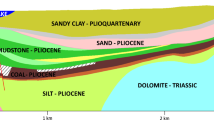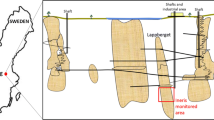Abstract
Single-link cluster is introduced into mine microseism monitoring from a seismology point of view. The changes in spatial correlation length of mine microseismic events at different spatial scales are analyzed, and the underlying mechanisms are explained. The results show that large-energy microseismic events often occur after the spatial correlation length drops to a low value when the spatial scale is large. The larger the energy of microseismic events is, the more obvious the law is. Large-energy microseismic events occur after the spatial correlation length exhibits the power-law growth phenomenon, when the spatial scale becomes small. The smaller the spatial scale is, the more obvious the law is. The reason for this property is that microseismic events exhibit the space aggregation phenomenon before a large-energy microseismic event occurs, resulting in decreases in spatial correlation length when the spatial scale is large. By contrast, when the spatial scale is small, the spatial correlation degree of regional microseismic sources is high. Small-energy microseismic events occur gradually with concentration in low-intensity regions, and a large number of small cracks are produced before a large microseismic event occurs. The microseismic source is dispersed again once the regional stress is released. The entire system achieves a critical state. There is small cracks coalescence at a particular moment, which triggers a large-energy microseismic event. Therefore, it exhibits the phenomenon of power-law growth of the correlation length before the occurrence of the large-energy microseismic event. Moreover, statistical analysis of the bond length and frequency of SLC is performed. The result is that three non-scale ranges are identified. The turning points of the first two nonscale ranges are 180 m and 240 m, respectively, while the turning points of the second and third non-scale ranges are both approximately 450 m. The difference between the first turning points is due to the artificial disturbance, while the second turning point is affected by the geological environment.
Similar content being viewed by others
References
Antoni, M.C. and Mercè, U., 2001, Some dynamical characteristics of microseism time-series. Geophysical Journal International, 149, 589–598.
Antoni, M.C., Mercè, U., and Josep, V., 2007, Microseism activity and equilibrium fluctuations. Nonlinear Dynamics in Geosciences, 1, 69–86.
Blake, W., 1982, Microseism applications for mining–a practical guide. Open-file report 52083, Bureau of Mines, U.S. Department of the Interior, Washington DC, 206 p.
Bowman, D.D., Ouillon, G., and Sammis, C.G., 1998, An Observation Test of the Critical Earthquake Concept. Journal of Geophysical Research, 24, 359–372.
Bruce, A. and Wallace, D., 1989, Critical point phenomena: universal physics at large length scales. In: Davies, P. (ed.), The New Physics. Cambridge University Press, New York, p. 236–267.
Cai, W., Dou, L.M., and Li, Z.L., 2014, Microseism multidimensional information identification and spatio-temporal forecasting of rock burst: A case study of Yima Yuejin coal mine, Henan, China. Chinese Journal of Geophysics, 57, 2687–2700.
Christopher, M. and Michael, G., 2016, Evaluating the risk of coal bursts in underground coal mines. International Journal of Mining Science and Technology, 26, 47–52.
Davis, S.D. and Frohlich, C., 1991, Single-link cluster analysis, synthetic catalogues and after-shock identification. Geophysical Journal International, 104, 289–386.
Feng, J.J., Wang, E.Y., Shen, R.X., Chen, L., Li, X.L., and Li, N., 2016, A coal shear fracture source model and its far-field seismic characteristics. Journal of China University of Mining & Technology, 45, 483–489.
Frohilch, C. and Davis, S.D., 1990, Single-link cluster analysis as a method to evaluate temporal and spatial properties of earthquake catalogues. Geophysical Journal International, 100, 19–32.
Fujii, Y., Ishijima, Y., and Deguchi, G., 1997, Prediction of coal face rock bursts and microseismity in deep longwall coal mining. International Journal of Rock Mechanics and Mining Science, 34, 85–96.
Ge, M.C., 2005, Efficient mine microseism monitoring. International Journal of Coal Geology, 64, 44–56.
Gibowicz, S.J. and Kijko, A., 1994, An Introduction to Mining Seismology. Academic Press, San Dieg, 399 p.
Jiang, F.X., Yang, S.H., and Cheng, Y.H., 2006, A study on microseism monitoring of rock burst in coal mine. Chinese Journal of Geophysics, 49, 1511–1516.
Jiang, Y.D., Pan, Y.S., and Jiang, F.X., 2014, State of the art review on mechanism and prevention of coal bumps in China. Journal of China Coal Society, 39, 205–213.
Keilis-Borok, V., IsmailS-Zadeh, A., and Kossobokov, V., 2001, Non–linear dynamics of the lithosphere and intermediate-term earthquake prediction. Tectonophysics, 338, 247–260.
Kasahara, K., 1981, Earthquake Mechanics. Cambridge University Press, New York, 248 p.
Lei, X.L., Masuda, K., and Nishizawa, O., 2004, Detailed analysis of acoustic emission activity during catastrophic fracture of faults in rock. Journal of Structural Geology, 26, 247–258.
Li, T., Cai, M.F., and Cai, M., 2007, A review of mining-induced seismicity in China. International Journal of Rock Mechanics and Mining Sciences, 44, 1149–1171.
Li, C.W., Liu J.K., and Wang, C.X., 2012, Spectrum characteristics analysis of microseismic signals transmitting between coal bedding. Safety Science, 50, 761–767.
Liu, Z. and Zhou, H.L., 1997, Study on Single-Link Cluster Algorithm and Its Implementation. Journal of Graduate School, Academia Sinica, 14, 57–65.
Liu, J.P., Li, Y.H., and Tian, J., 2010, Experimental study of temporal and spatial distribution characteristics of acoustic emission during rock fracture based on Single-Link Cluster method. Chinese Journal of Rock Mechanics and Engineering, 29, 3488–3497.
Liu, C., Xue, J.H., Yu, G.F., and Chen, X.Y., 2016, Fractal characterization for the mining crack evolution process of overlying strata based on microseismic monitoring technology. International Journal of Mining Science and Technology, 26, 295–299.
Lu, C.P., Dou, L.M., and Liu, B., 2012, Microseismic low-frequency precursor effect of bursting failure of coal and rock. Journal of Applied Geophysics, 79, 55–63.
Ma, Y.L. and Zhou, H.L., 2000, Temporal and spatial statistical characteristics of earthquakes in China by Single-Link Cluster method. Chinese Journal of Geophysics, 43, 175–182.
Mcgarr, A., 1976, Seismic moments and volume change. Journal of Geophysical Research, 81, 1487–1494.
Mendecki, A.J., 1997, Seismic monitoring in mines. Chapman and Hall, London, 262 p.
Mogi, K., 1962, Study of elastic shocks caused by the fracture of heterogeneous materials and its relations to earthquake phenomena. Bull Earthquake Research Institute, 40, 125–173.
Press, F. and Allen, C., 1995, Pattern of Earthquake Release in the Southern California Region. Journal of Geophysical Research, 100, 6421–6430.
Rong, D.L. and Li, Y.R., 2012, Growing Phenomena of Seismic Spatial Correlation Length before Japan M9.0 Earthquake in 2011. Journal of Seismological Research, 35, 157–161.
Rong, D.L. and Li, Y.R., 2013, Analysis of the growth phenomenon of seismic correlation length prior to Minxian-Zhangxian earthquake. China Earthquake Engineering Journal, 35, 455–458.
Rong, D.L., Li, Y.R., and Liu, X.Z., 2004, Study on growing correlation length prior to the earthquakes occurred in Gansu Province and its nearby area. Acta Seismologica Sinica, 26, 509–515.
Shearer, P.M., 2009, Introduction to Seismology (2nd edition). Cambridge University Press, New York, 396 p.
Sun, J., Wang, L.G., and Hou, H.Q., 2012, Application of micro-seismic monitoring technology in mining engineering. International Journal of Mining Science and Technology, 22, 79–83.
Turcotte, D.L., Newmen, W.I., and Shcherbakov, R., 2003, Micro and macroscopic model of rock fracture. Geophysical Journal International, 152, 718–728.
Tyupkin, Y.S. and Giovambattista, R.D., 2005, Correlation length as an indicator of critical point behavior prior to a large earthquake. Earth and Planetary Science Letters, 230, 85–96.
Vinoth S. and Ajay K.L., 2014, Applying real time seismic monitoring technology for slope stability assessment–An Indian opencast coal mine perspective. International Journal of Mining Science and Technology, 24, 75–80.
Wang, C.L., Wu, A.X., and Liu, X.H., 2009, Study on fractal characteristics of b value with microseismic activity in deep mining. Procedia Earth and Planetary Science, 1, 592–597.
Xia, Y.X., Pan, J.F., and Wang, Y.J., 2011, Study of rule of surrounding rock failure and stress distribution based on high precision microseism monitoring. Journal of China Coal Society, 36, 239–243.
Yang, C.X., Luo, Z.Q., and Hu, G.B., 2007, Application of a microseism monitoring system in deep mining. Journal of University of Science and Technology Beijing, Mineral, Metallurgy, Material, 14, 6–8.
Yang, Z.G., Yu, R.C., and Guo, R., 2009, Research of mining based on microseismic monitoring technology in high-stress area. Chinese Journal of Rock Mechanics and Engineering, 28, 3632–3638.
Zhang, M., Jiang, F.X., Li, K.Q., Zhai, M.H., and Yang, G.D., 2016, Study of disasters induced by key strata instability near stopping boundary in the process of repeated coal mining. Journal of China University of Mining & Technology, 45, 915–922.
Zhou, H.L., Liu, Z., and Gao, Y., 1997, SLC Method and Earthquakes' Clustering Features in Time–Space in the Top Area of Kunlun- Altun-Arc. Earthquake Research in China, 13, 197–206.
Zhou, H.L., Liu, Z., and Ma, Y.L., 1999, Single-Link-Cluster Method to Distinguish the Pre-and After-shocks. Earthquake Research in China, 15, 210–219.
Zöller, G., Hainzl, S., and Kurths, J., 2001, Observation of growing correlation length as an indicator for critical point behavior prior to large earthquakes. Journal of Geophysical Research, 106, 2167–2175.
Author information
Authors and Affiliations
Corresponding author
Rights and permissions
About this article
Cite this article
Zhang, Z., Wang, E. & Li, N. Temporal and spatial characteristics of coal-mine microseism based on single-link cluster. Geosci J 21, 223–233 (2017). https://doi.org/10.1007/s12303-016-0038-5
Received:
Accepted:
Published:
Issue Date:
DOI: https://doi.org/10.1007/s12303-016-0038-5




